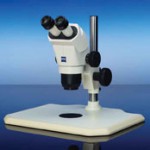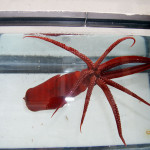
Eddies are an important nexus between physical oceanography and marine biology because these giant swirling tornadoes of seawater are pervasive in the world’s oceans. Passing eddies can accelerate local currents, retain and transport plankton and nutrients, enhance open water productivity, and stimulate fast, deep sinking. Quasi-permanent eddies can retain larvae in the lee of an island, for example. Eddies are easily detectible by satellites. Important charismatic megavertebrates like sea turtles, elephant seals, blue whales, and sperm whales seem to track these pelagic features, presumably because they aggregate prey species.
A recent article in Geophysical Research Letters from Gilberto Jeronimo and Jose Gomez-Valdes at Centro de Investigacion Cientifica y de Educacion Superior de Ensenada (CICESE) in Mexico reports that some deep eddies can go undetected by satellite, because they remain submerged. Notice you can’t see one in the NOAA sea surface temperature image above. ; )
The researchers conducted a 21-day hydrographic survey in the southern region of the California Current, and observed for the first time a subsurface anticyclonic (warm core) eddy off northern Baja California with the same water mass characteristics as the California Undercurrent. The core of the eddy was quasi-circular with radii of 35 km and thickness of 250 m.
The abstract is here.






But could we harvest the water from the eddy and sell it?
It’s a warm core eddy, so it’s downwelling. We should look for a cold core eddie that’s upwelling, and poke it with a giant straw mounted on the CHIKYU. Once the water starts coming up into warmer surface, it should expand due to cabeling.